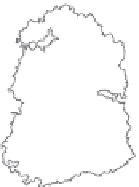Environmental Engineering Reference
In-Depth Information
Most species do not migrate like swallows, but their powers of movement are
equally important to future distribution. Note that the term 'power of movement' is
a broad one that includes the ability of plants to progress through the landscape via
dispersal of their seeds. A crucial question is whether species under the infl uence
of global climate change will be able to keep up with the rate of movement of their
habitable areas. History shows that tree species have changed and recovered distri-
bution patterns with the waxing and waning of the ice ages. But is human-induced
global warming going to move too fast? And in human-modifi ed landscapes, will
there be suffi cient stepping-stones of habitable areas that are relatively
undisturbed?
The question has been addressed for trees in North America including sweetgum
(
Liquidambar styracifl ua
), a species currently confi ned to the eastern half of the USA.
Iverson et al. (2004) fi rst used niche modeling to defi ne the fundamental niche of
the species and then ran a climate change model to predict habitable area in 2100.
A considerable expansion of range is predicted to the north and east (Figure 11.8a,b).
They then inserted another modeling step called 'SHIFT'. This involves calculating
the probability of dispersal to each unoccupied 1 km
2
cell to the northeast of the
current distribution. The probability of successful colonization is based on habitat
quality in the unoccupied cell, abundance of sweetgum in each occupied cell, dis-
tances between occupied and unoccupied cells and a maximum migration rate of
50 km/century (estimated from historical records). The model was run for 100 years,
Fig. 11.8
(a) Current
distribution of
sweetgum trees across
the eastern USA (darker
colors show greater
habitat quality - an
index of density and
size of trees) w ith the
1971 range outlined in
black. (b) Predicted
distribution of
sweetgum in 2100,
assuming that rate of
dispersal can keep
up with change in
habitable area. (c)
Actual occupied area in
2100 is predicted to be
very much less than the
potential area, because
of dispersal restrictions.
This panel, which
focuses in on the
current range boundary
(indicated by the box in
(b)), shows the
presently occupied
range in gray and the
surprisingly small
addition by 2100 of
newly occupied habitat
immediately to the
northeast. According to
the predicted distribu-
tion in (b), all of the
area depicted in (c)
could, in theory, be
occupied by sweetgum
if only they could shift
fast enough. (From
Iverson et al., 2004.)
(This fi gure also
reproduced as color
plate 11.8.)
a
b
c































































































Search WWH ::

Custom Search